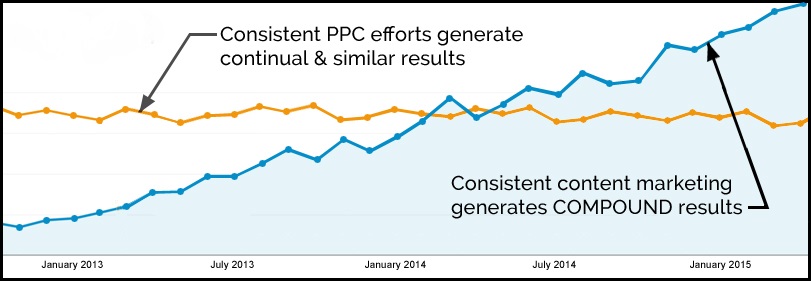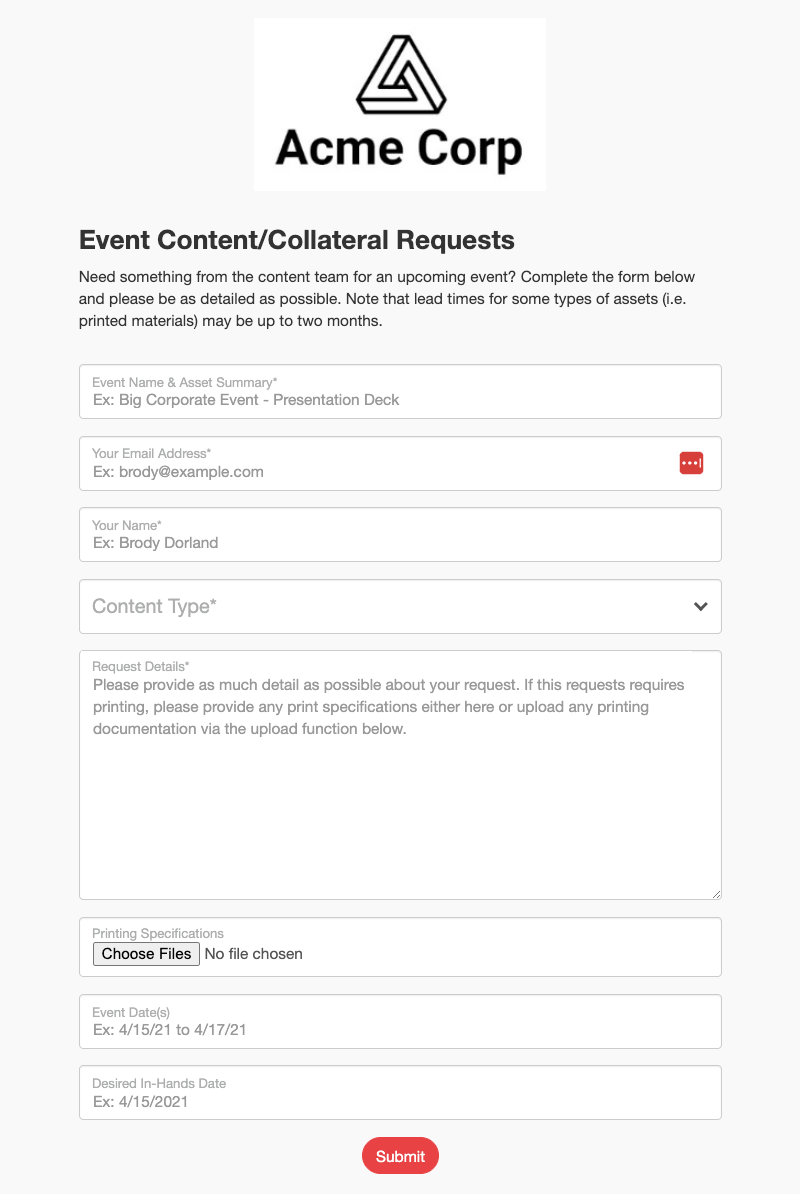A 2022 survey of content marketers worldwide revealed that 80% think their org’s content marketing strategy is very successful. On the upside, content marketing success leads to a happy C-suite and job security for content teams.
On the downside, once internal stakeholders learn about how successful your team is, you become inundated with content requests from everyone who want to reap the rewards of killer content. While knowing your team provides a valued service is a great feeling, juggling so many demands can be a nightmare. Not to mention the challenges of determining which requests you can fulfill and how to prioritize the ones you accept.
So, how do you handle this situation? Content requests are coming in from every area of your business. Like a good content marketer, you have content quality standards to maintain. But your resources are finite. And some of the requests definitely don’t align with your defined strategy.
Whether or not you have a formalized content request intake process, requests often need to be handled on a case-by-case basis. Requests from different departments, or different types of stakeholders may not be treated equally.
Luckily, we have some useful pointers for you to help you wrap your heads around the process, and a playbook that you can follow to properly manage this situation. Bottomline, we don’t want any content manager feeling like a content vending machine.
Key Takeaways:
- Content teams are often inundated with content requests from multiple stakeholders across the organization.
- Stakeholder requests cover numerous topics, formats, and audiences.
- Though marketing and sales are often key players, other departments can place high demands on content teams.
- Using a central hub that includes content request tools, workflows, and automation ensures a smooth and efficient content production process.
Table of Contents
The Content Requests Team of Players
- The Marketing Stakeholder
- The Sales Stakeholder
- The Customer Success Stakeholder
- The Executive Stakeholder
- The Subject Matter Expert Stakeholder
- The Events Stakeholder
- The Public Relations Stakeholder
- The Human Resources Stakeholder
- The Training and Development Stakeholder
Playbook Creation and Implementation
Are You Ready to Formalize Your Content Requests Process?
The Content Requests Team of Players
As a large content operation, you undoubtedly funnel requests from across your organization. Have you ever taken the time to document which departments and stakeholders are interested in content and what formats they often need?
One of the first steps to dealing with the potential onslaught is to know what (and who) you’re up against. It’ll help you build your content strategy and maintain organization during content planning.
The Marketing Stakeholder
Whether your content team is couched within your marketing department or separate, marketing is probably one of your most consistent and significant stakeholders. Under the umbrella of marketing, you may receive requests from:
- The social media team
- The product marketing team
- Branding specialists
- SEO strategists
- Web designers
Though the overarching goal for a marketing department is to increase awareness and conversions, each of these players has their own objectives and content needs. They may target a specific audience segment or need helpful content for any potential customer or the business itself.
While content formats often overlap, the type of information can vary. You may receive content requests for social media posts, videos, blog articles, promotional or advertising materials, infographics, eBooks, or case studies. The product marketing team may also need optimized product descriptions and technical specs.
The pressure to produce content for the marketing department can be significant, with requests flooding in daily. It isn’t hard to see why content teams become overwhelmed and unable to think further than churning out the next asset. Using Divvy’s collaboration tools allows your team to work closely with the marketing department to reduce the chaos of moving large volumes of content from ideation to publication.
The Sales Stakeholder
Dealing with content requests from the marketing department is challenging, but it doesn’t stop there. The sales department often has almost as great a content need as marketing.
Marketing and sales are responsible for moving prospects through the buyer’s journey. Inbound content marketing generates three times as many quality leads as paid marketing. It can also significantly boosts sales, so it makes sense that content is a key asset within a sales enablement strategy.
Source: Marketing Insider Group
Though the sales department’s primary focus is selling, sales managers and salespeople know that their jobs are easier if they have helpful, relevant content to support their efforts. They may submit content requests for emails, product demo videos, case studies, how-to guides, one-pagers, and landing pages. Any content that links marketing’s target audience to sales channels helps the sales department nurture leads and convert them into paying customers.
The Customer Service Stakeholder
The Customer Service department fields customer concerns and questions and plays a significant role in repeat sales and retention. They need content to onboard and train customers, maintain interest, and improve satisfaction after an initial sale.
They also understand what keeps customers coming back for more. Producing content that solves post-purchase concerns or encourages upsells or cross-sales is essential for customer satisfaction and retention.
Your customer journey map should include content aimed at solving the problems and addressing the pain points of current customers. Divvy’s calendar and filtering capabilities can help you ensure you don’t overlook this vital audience segment and its content needs.
The Executive Stakeholder
Fielding content requests from the C-suite can be a delicate dance. They have their eyes on the competition and hold the purse strings. Expectations are usually high, and patience is often low.
With Divvy’s slick reporting tools, you can keep them in the content strategy loop and abreast of content campaign performance. Still, if they see something that sparks their concerns about staying ahead of the competition, there’s little doubt you will hear about it, along with a request to do the same, only better.
The Subject Matter Expert Stakeholder
Subject matter experts may be internal or external stakeholders. You depend on them to provide the insight and information your team needs to craft compelling and helpful content.
However, they may have their own ideas about what you should publish on your company site. They may develop a topic they hope to write themselves and post on your blog. How do you handle these content requests when they come in, knowing you need to count on your SMEs for future content? Work collaboratively and support them, especially when their ideas fall right in line with your strategy. If the idea isn’t an obvious fit, help them mold it into something that does.
The Events Stakeholder
If your team handles content across your organization, you likely field requests from the events team. This group may call on you regularly to fulfill its annual and special-event needs.
They may seldom give you enough lead time to fit content production for their required assets into your already hectic schedule. Generating ideas for signage, information packets, and press releases may seem less weighty than other content you deal with, but if you are to maintain quality and stay on top of all content requests that head your way, you need a system that works for your team even when last-minute demands hit your inbox.
DivvyHQ Screenshot – Example of an Events Collateral Request Form
The Public Relations Stakeholder
The PR stakeholder requires content that promotes your brand. It comes in various-but-predictable formats, from press releases to editorial content for print and online media channels, to podcasts and informational interviews.
Though the formats are predictable, the topics and promotional content schedule usually aren’t. You may not have sufficient lead time to generate a script or news outlet article. Make sure your PR team has access to your content calendar, and you have access to theirs, so you all can coordinate effectively.
The Human Resources Stakeholder
Internal comms teams usually produce HR’s content materials. If this is you, you’re likely creating everything from job descriptions and recruiting videos to the company newsletter and employee recognition articles.
The requests you receive from HR may be less predictable and more irregular than those of other stakeholders. However, when the department has a content need, your team is usually expected to fill it.
The Training and Development Stakeholder
Training and development may submit regular requests for various content that deals with employee education. They might need an email reminding staff of an upcoming training or a webinar designed to improve a skillset. If your company has any compliance requirements, you can expect to hear from this department every time an audit looms or a policy changes.
Playbook Creation and Implementation
With content requests from so many players pouring in daily, you need a streamlined process for request intake, submission, review and approval, or rejection of the request. You also need an established method for moving an approved request onto your production schedule without it slipping through any process cracks.
After all, you can’t create a winning team without a playbook that provides the strategy for dealing with every situation your team might confront. The playbook should define how to accomplish the team’s tasks, including player roles and responsibilities.
You and your team likely feel like you exist to serve all the stakeholders sending requests for content your way. However, your ultimate responsibility is to your target audiences. If you don’t create relevant, consistent, and helpful content, your content won’t get the attention and engagement you seek. Your brand will lose customers and employees.
Struggling to stay a step ahead of requests can reduce your team’s focus on creating killer content that meets audience needs and reflects your brand’s voice, values, and mission. As a result, the success goalposts for every stakeholder move further down the playing field. Combating this to accomplish all the departments’ goals requires the right process and tools.
Create a System
You need a single system for managing content requests and initiating and completing the content production process. Using one system to handle it all ensures stakeholders know where and how to submit proposals for new content, and your team understands how to carry the ball to the finish line.
Define your system and communicate it with your team and the rest of your organization. Standardizing the entire content process, from request to analysis and reporting, reduces confusion and chaos. It also puts everyone on the same page.
Your system should include:
- A formalized request submission process (request form builder, request inbox for triaging submissions, etc.)
- An established procedure for reviewing requests
- Guidelines for accepting, modifying, or rejecting requests
- An automatic process for moving accepted requests into content production
- Automated workflows for each process
Efficiency is key. You don’t need to create anything complicated; you just need a structure and process that everyone knows and can follow.
Utilize a Central Hub
Creating a system is obviously an important start, but you’re still going to need some dedicated tech to facilitate your process. If you receive content requests via Slack, email, text message, and old-school paper form, you’ll waste a lot of time sorting those requests and ensuring they get to the right people to assess and approve or reject, and then to the creatives who will craft the content.
Divvy’s platform provides the central hub you need. Anything and everything your team needs to deal with stakeholder requests and produce awesome content lives on our platform.
Our Content Requests Tool helps you formalize your request intake and approval process, no matter where those requests originate. Our tool helps you:
- Create one or multiple request/intake forms
- Share the forms with stakeholders or allow access via a public URL
- Receive notifications as soon as a stakeholder submits a request
- Manage content requests within a dedicated interface
- Trigger an automated workflow for request reviews, edits, and approvals
- Comment on submissions for efficient collaboration
- Convert approve requests into active projects and schedule them via your content calendar
- Archive denied requests
- Keep request submittors in the loop on the status of their requests
Our tool makes creating and implementing your playbook easier, including streamlining it with the content production process.
DivvyHQ Screenshot: Content Requests Admin Interface
Numerous workflow and collaboration features allow you to establish a process and assign tasks and deadlines using custom templates. You can also automate your workflows to ensure requests and assets move smoothly through their processes.
Playbook Considerations
While creating and implementing your playbook provides the system and structure you need to deal with requests for content from every stakeholder ever, there are a few factors to consider when managing any request:
- Strategic: Your content strategy is the primary playbook, ensuring the content you produce moves you closer to achieving your content goals. It provides the framework for everything your team does. When reviewing content requests, you must consider whether the requests align with your strategy. If they don’t, can the requester reframe their topics? If not, you may need to reject the proposal.
- Political: While you can theoretically reject requests, company politics often dictate how much power you have to deny a stakeholder’s proposal outright. Can you imagine saying no to an executive, even if what they want you to do doesn’t align with your strategy?
- Incentivizing: Prioritizing requests according to your content publication cadence, content already on the schedule, and the order in which you received the request seems logical. However, you might need to do some shuffling if you get a request from an SME, knowing you need to count on them to help you out later.
Even given these additional considerations, establishing a system and process for dealing with any kind of request you might receive will help you and your team continue to craft content that drives results for your brand. Everyone benefits, even if they may grumble about this new process when you first implement it.
Are You Ready to Formalize Your Content Requests Process?
Divvy’s platform provides all the tools you need to implement an efficient and effective system for handling project intake and content requests. Our customizable and shareable request tool is integrated with the rest of the system, allowing you to easily shift from request submission to content production.
Let us handle the technical heavy lifting while you and your team focus on satisfying your audiences and organizational stakeholders. Request a demo today to see how we simplify your content requests and production processes.





